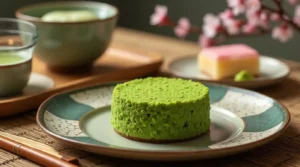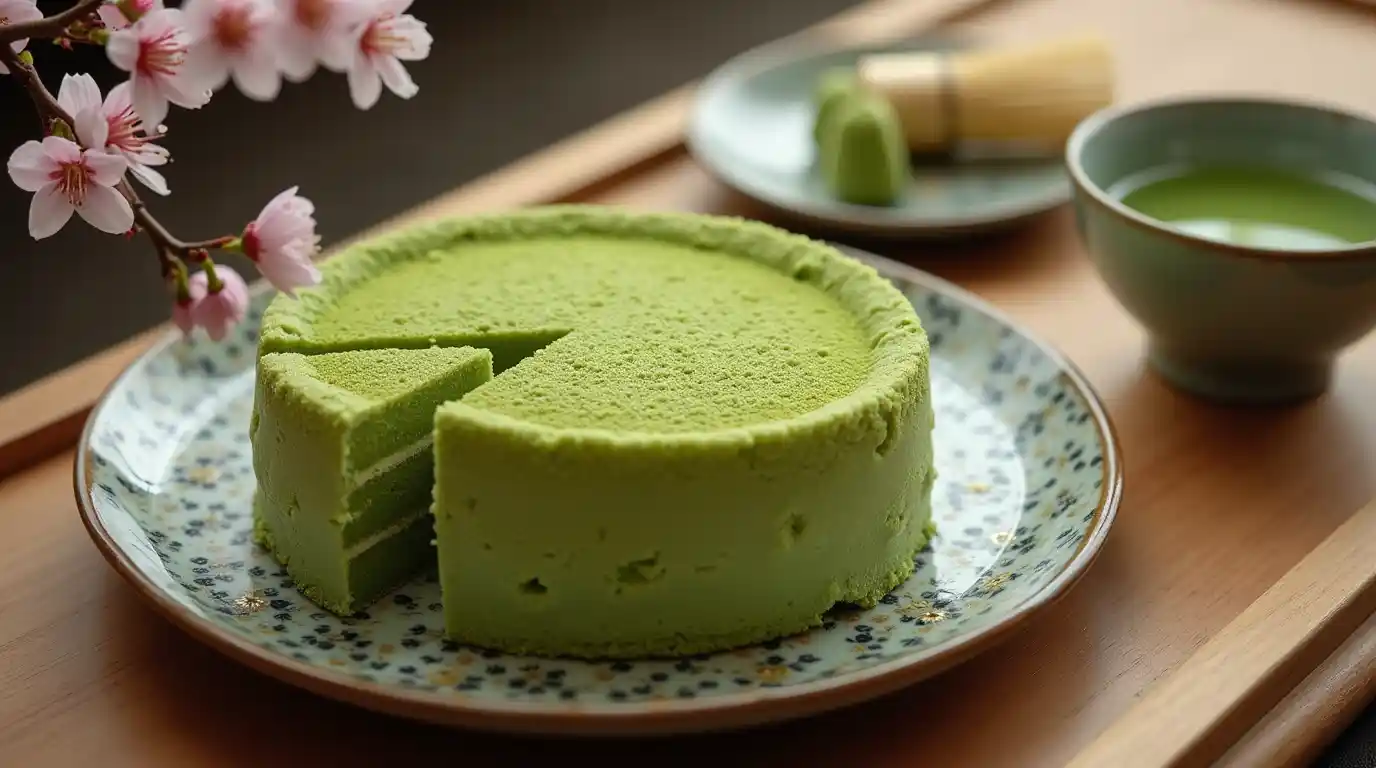Japanese matcha cake is a culinary masterpiece that combines the rich, earthy flavors of matcha with the delicate sweetness of cake. This vibrant green dessert has become a global sensation, celebrated for its unique taste, stunning appearance, and cultural significance. Whether you’re a seasoned baker or a curious foodie, this article will guide you through everything you need to know about Japanese matcha cake, from its origins to how you can make it at home.
What is Matcha?
Matcha is a finely ground powder made from shade-grown green tea leaves. Unlike regular green tea, matcha is consumed whole, offering a more concentrated flavor and a wealth of health benefits. The production process involves:
- Growing tea leaves under shade to boost chlorophyll and amino acids.
- Hand-picking the youngest leaves for their vibrant color and flavor.
- Stone-grinding the leaves into a fine powder.
This meticulous process gives matcha its signature earthy, slightly bitter taste and vibrant green hue. It’s no wonder that matcha has been a cornerstone of Japanese tea culture for centuries. If you’re curious about the history of matcha.
The Rise of Matcha in Baking
The use of matcha in baking is a relatively modern twist on traditional Japanese cuisine. As matcha gained popularity worldwide, bakers began experimenting with its unique flavor profile, leading to the creation of Japanese matcha cake.
- Why Matcha Works in Baking:
- Its vibrant color adds visual appeal to desserts.
- Its earthy flavor balances the sweetness of cakes.
- It’s packed with antioxidants, making it a healthier alternative to artificial food coloring.
Today, matcha cake is a staple in Japanese bakeries and has inspired countless variations, from matcha cheesecake to matcha roll cake. For more on the health benefits of matcha.
Types of Japanese Matcha Cakes
Japanese matcha cake comes in many forms, each with its own unique texture and flavor. Here are some popular varieties:
- Matcha Sponge Cake: Light and airy, perfect for layering.
- Matcha Cheesecake: Creamy and rich, with a hint of bitterness.
- Matcha Roll Cake: A soft, rolled cake filled with whipped cream or red bean paste.
- Matcha Chiffon Cake: Fluffy and moist, often served as a tea-time treat.
- Matcha Pound Cake: Dense and buttery, with a strong matcha flavor.
These cakes showcase the versatility of matcha and its ability to elevate traditional desserts.
Why Japanese Matcha Cake is Unique
What sets Japanese matcha cake apart from other desserts?
- Flavor Profile: A perfect balance of earthy bitterness and sweetness.
- Vibrant Color: The natural green hue of matcha makes the cake visually stunning.
- Cultural Significance: Matcha is deeply rooted in Japanese tea culture, adding a layer of tradition to every bite.
How to Make Japanese Matcha Cake at Home
Ready to try your hand at baking Japanese matcha cake? Here’s a simple recipe for a classic matcha sponge cake:
Ingredients:
- 1 ½ cups all-purpose flour
- 2 tbsp high-quality matcha powder
- 4 large eggs
- 1 cup granulated sugar
- ½ cup milk
- ¼ cup unsalted butter (melted)
- 1 tsp vanilla extract
Instructions:
- Preheat your oven to 350°F (175°C) and line a cake pan with parchment paper.
- Sift the flour and matcha powder together to remove lumps.
- Whisk the eggs and sugar until light.
- Gradually fold in the dry ingredients, followed by the milk, melted butter, and vanilla extract.
- Pour the batter into the prepared pan and bake for 25–30 minutes.
- Let the cake cool before serving.
Tips for Baking the Perfect Matcha Cake
- Choose High-Quality Matcha: Look for ceremonial-grade matcha for the best flavor and color.
- Avoid Overmixing: Overmixing can result in a dense cake.
- Store Properly: Keep your cake in an airtight container to maintain freshness.
Pairing Japanese Matcha Cake with Beverages

One of the joys of enjoying Japanese matcha cake is pairing it with the perfect beverage. The right drink can elevate the flavors of the cake, creating a harmonious balance that delights the palate. Whether you prefer traditional Japanese teas or modern twists, here are some excellent pairing options:
1. Traditional Japanese Tea Pairings
Matcha Tea
- Why It Works: Pairing matcha cake with matcha tea creates a cohesive flavor experience. The earthy, slightly bitter notes of the tea complement the sweetness of the cake, enhancing its depth.
- Serving Suggestion: Opt for a bowl of usucha (thin matcha) for a lighter pairing or koicha (thick matcha) for a more intense flavor.
Sencha
- Why It Works: Sencha, a steamed green tea, has a fresh, grassy flavor that contrasts beautifully with the creamy sweetness of matcha cake.
- Serving Suggestion: Brew sencha at a lower temperature (around 70°C or 158°F) to avoid bitterness and bring out its natural sweetness.
Hojicha
- Why It Works: Hojicha, a roasted green tea, has a toasty, nutty flavor that pairs wonderfully with the earthy tones of matcha cake. Its low caffeine content also makes it a great option for evening desserts.
- Serving Suggestion: Serve hojicha warm to highlight its comforting aroma.
2. Modern Beverage Pairings
Coffee
- Why It Works: The bold, robust flavors of coffee create a striking contrast with the delicate sweetness of matcha cake. This pairing is perfect for those who enjoy a balance of bitter and sweet.
- Serving Suggestion: A latte or cappuccino works best, as the milk softens the bitterness of the coffee.
Milk Tea
- Why It Works: The creamy, slightly sweet profile of milk tea complements the richness of matcha cake. The tea’s tannins also help cut through the cake’s sweetness.
- Serving Suggestion: Try a classic black milk tea or a jasmine milk tea for a floral twist.
Sparkling Water
- Why It Works: For a refreshing and light pairing, sparkling water cleanses the palate between bites of matcha cake, allowing you to fully appreciate its flavors.
- Serving Suggestion: Add a slice of lemon or lime for a citrusy kick.
3. Creating a Complete Japanese Dessert Experience
To truly immerse yourself in the Japanese dessert experience, consider serving matcha cake as part of a larger spread. Here are some ideas:
- Dessert Platter: Pair the cake with mochi, dorayaki, or wagashi (traditional Japanese sweets).
- Tea Ceremony: Host a mini Japanese tea ceremony with matcha cake as the centerpiece. Use a chawan (tea bowl) and chasen (bamboo whisk) to prepare the matcha tea.
- Seasonal Touches: In spring, pair the cake with sakura-flavored tea or cherry blossom-infused water. In winter, serve it with a warm cup of genmaicha (green tea with roasted brown rice).
Why Pairing Matters
Pairing Japanese matcha cake with the right beverage isn’t just about taste—it’s about creating a multisensory experience. The right drink can enhance the cake’s flavors, balance its sweetness, and even evoke a sense of Japanese tradition and culture.
Health Benefits of Japanese Matcha Cake
Matcha is rich in antioxidants, vitamins, and minerals, making matcha cake a healthier dessert option. Some benefits include:
- Boosting metabolism.
- Enhancing focus and relaxation.
- Supporting heart health.
FAQs About Japanese Matcha Cake
- What does matcha cake taste like?
- It has a balance of earthy, slightly bitter matcha with sweet, creamy flavors.
- Can I use regular green tea instead of matcha?
- No, matcha has a unique flavor and texture that regular green tea cannot replicate.
- Is matcha cake healthy?
- It can be, depending on the recipe and portion size. Matcha is rich in antioxidants.
- How long does matcha cake last?
- Typically 2–3 days when stored in an airtight container.
- Where can I buy matcha powder for baking?
- Specialty tea shops, Japanese grocery stores, or online retailers.
Conclusion
Japanese matcha cake is more than just a dessert—it’s a celebration of Japanese culture and culinary artistry. Whether you’re enjoying it at a bakery or baking it at home, this vibrant green treat is sure to delight your taste buds. So why not give it a try?


No baking powder or soda?